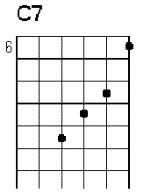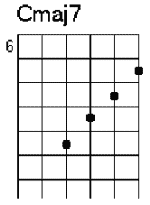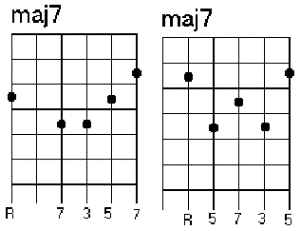
7th ChordsPreviously we looked at triads, three-note chords which are formed by stacking various combinations of major and minor 3rd intervals. Now we're going to look at four note chords. Let's review for a second how we build a major triad. As usual, we'll start with C. The major third above C is E. A minor third above E is G, so our C major triad is C-E-G. But what would happen if we continue to add major or minor third intervals? We'd build a 7th chord, that's what would happen. Let's add the next minor third to the above sequence: C-E-G-Bb This is a C7, or C dominant 7 chord. It's really important to note that the new note (Bb) is the flatted 7th degree of the C major scale. This is something you just have to commit to memory, because there's really nothing in the chord name to tell you that it's a flatted 7th. The same principle applies to minor chords: C-Eb-G-Bb This is a Cm7 chord. Any time you see a chord name written like this (C7, E7, F#m7, etc.) it means a flatted 7th. Why are they called dominant 7 chords instead of just flat 7 chords? Good question, and except for the chord based on the 5th tone of the scale (the "Dominant" tone) they probably shouldn't be called dominant 7 chords. As always, let's look at the key of C. The fifth, or dominant, tone is G. The natural 7th of G is F#, but since that's not diatonic to C we flatten the F# to F. That F gives a tension that resolves well on the major 3rd of the tonic chord (C), so that gives us a nice "cadence." I think over the years we just let people get away with being a little reckless with using "dominant 7" to mean any flatted-7th chord. Personally, I try to always call 'em either just "7" or "flat-7" chords, unless I'm actually talking about the dominant chord of the key. You can also build a seventh chord by adding the next major third interval to the sequence: C-E-G-B This gives you a C major 7 chord. The new note (B) is the natural 7th degree of the C major scale. You will see this written as Cmaj7, C with a little triangle or delta before the 7 (can't seem to do that in HTML) or even CM7. It's important to remember that "major 7" in this case refers to the "major" or natural 7th degree of the chord, not the third. These can also be major or minor, so you can wind up with a seemingly-oxymoronic chord name like Cminor-major 7, which would include a minor 3rd and a natural 7th. The nomenclature seems a little goofy to me, but at least it's consistent. In a way it makes sense to simplify the name of flat 7 chords because they are 'way more common than major 7 chords. Here are some fingering patterns: |
 |  |
 |
|
Next time, we'll apply some of this junk to a standard 12-bar blues progression.
|
Back to instruction page.
Questions? Comments?E-mail me!